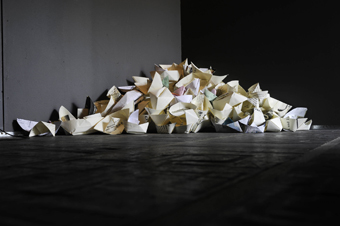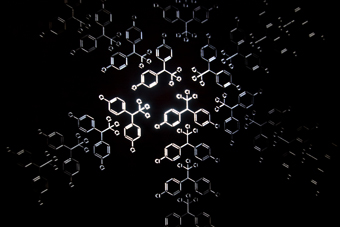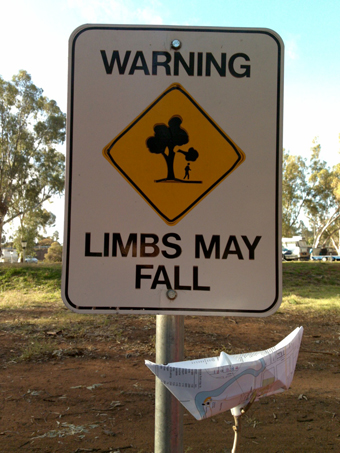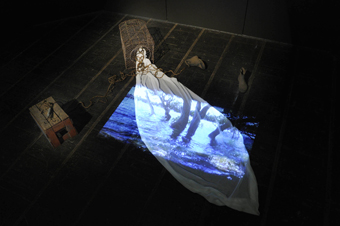the shapes of water
gail priest: memory flows, newington armory

In Search of the Inland Sea, 2009, Norie Neumark, Maria Miranda
photo Adam Hollingworth
In Search of the Inland Sea, 2009, Norie Neumark, Maria Miranda
MEMORY FLOWS IS AN ONGOING PROJECT OF THE CENTRE FOR MEDIA ARTS INNOVATION (CMAI) AT THE UNIVERSITY OF TECHNOLOGY SYDNEY (UTS). UNDERTAKEN BY A LOOSE COLLECTIVE OF UTS STAFF AND AFFILIATED ARTISTS (OFTEN IN COLLABORATION), MEMORY FLOWS EXPLORES THE IDEA OF WATER AND ITS RELATION TO MEMORY, UTILISING SOUND, VIDEO, PHOTOGRAPHY AND SCULPTURE. SINCE ITS INCEPTION THERE HAVE BEEN SEVERAL PUBLIC OUTCOMES SUCH AS AT LIQUID ARCHITECTURE 2009 WITH THE PROJECT CULMINATING IN AN AMBITIOUS EXHIBITION PRESENTING 13 WORKS AT THE NEWINGTON ARMORY CURATED BY NORIE NEUMARK, DEBORAH TURNBULL AND SOPHIA KOUYOUMDJIAN.
The Newington Armory itself is quite a curious place—an eerie post-colonial ghost town left standing amidst the industrial sprawl of Silverwater (right next to a high security prison) on the mangrove fringed Parramatta River. On weekends it’s frequented by families as a leisure park with bike riding and roller-skating along the riverbanks. Approaching the Armory site it’s impossible not to contemplate the role of rivers in our ecosystem, the impact of modern civilisation on the landscape and the hidden histories of Sydney, and indeed Australia. Inside the exhibition, it is the works which approach these ideas more obliquely which prove to be most intriguing.

Diffusion, 2010, detail, Neil Jenkins, Roger Mills
courtesy of the artists
Diffusion, 2010, detail, Neil Jenkins, Roger Mills
Neil Jenkins and Roger Mills’ Diffusion (2010) draws you into a darkened space with the staticy sounds of running water made from hydrophonic recordings of the Parramatta River. The sounds issue from eight speakers hanging from the ceiling, each a beautifully crafted object: a wooden cube with an intricate structural diagram of a chemical pollutant laser-cut through one panel. Lit from within, the patterning gives each surface the appearance of a delicate lace-like screen. In the middle of the circle of speakers, textured images of water are projected, rendered mysterious by the intense detail. Moving around the work you experience a range of timbres of water sounds, often harsh and angular, reflecting the aggression of chemical infiltration, yet the beauty of the objects in the space is beguiling. (View video footage at http://www.eartrumpet.org/images/diffusion.mov)
Drawing Water (2009) by Jacqueline Gothe and Ian Gwilt is also evocative, comprising a large floor projection of gently undulating shapes—an abstract interpretation of the twists and turns of rivers from a topographical perspective. The image itself is not animated, yet it scrolls from left to right creating a disorienting sense of flow. The top down view and the interplay between stasis and movement create a sensation of the elusiveness of the shape of water.

In Search of the Inland Sea, 2009, video still, Norie Neumark, Maria Miranda
courtesy of the artists
In Search of the Inland Sea, 2009, video still, Norie Neumark, Maria Miranda
Co-curator Norie Neumark contributes a work made with long-time collaborator Maria Miranda, In Search of the Inland Sea (2009). Neumark and Miranda’s work frequently uses offbeat humour to approach serious issues (see the review of their Talking about the Weather). In this instance the idea of the elusive inland Australian sea which captivated early settlers is explored through a series of vignettes. The spine of the work is a road trip that the pair undertook retracing the explorer Sturt’s original journey down the Murrumbidgee and Murray Rivers. However they have substituted a small paper boat for Sturt’s impractical whaling vessel. Mobile phone video footage of the journey is presented on a small screen but the road trip narrative is complicated by a soundtrack which draws on the spoken description of the plot of a Japanese horror film, about creatures emerging from murky waters to abduct people. On another screen we see hands folding pages from an old book on Sturt into small paper boats while the voice over, rather than reading from the book, describes the look of the pages and the typography, hinting at the absurdity of colonial formalities. A pile of paper boats also fills one corner of the space beneath the screens. On yet another small screen an endless strip of outback road is accompanied by slowed down voices describing an action scene from Mad Max illustrating 20th century interpretations of the Australian landscape. Through the accumulation of these quirky juxtapositions, we get a sense of the complexity of the fantasies and fears of a non-Indigenous relationship with the Australian outback.

Cleanse, 2010, Megan Heyward
photo Adam Hollingworth
Cleanse, 2010, Megan Heyward
Several works used a more narrative approach to the thematic, recounting recollections of rivers and local waterways. The most stylish of these was Megan Heyward’s Cleanse (2010) which explores her childhood memories of the Parramatta River. Filmic-style video is down-projected onto a swathe of cloth issuing from a fishing trap. Scattered across the space are objects found around the river—old boots, fishing tackle, a wooden crate—which frame the viewing space. These memory fragments are intriguingly rich with a sense of the past, implying an innocence but also an ignorance in our past interaction with the ecosystem. Other works using documentary approaches, such as Shannon O’Neill and Jennifer Teo’s Waterfront Utopia (2010), Clement Girault and Victor Steffanson’s video component of Live Flows (2009), and to a lesser extent Ian Andrews’ Shifting Sands, are certainly accessible and informative if too illustrative for my taste, lacking complexity in the handling of their subjects.
While there was some similarity of approach, the standout works illustrated a range of stylistic and conceptual explorations on the thematic, and the venue choice added strong site-specific resonances to the exhibition. Perhaps more importantly Memory Flows introduced thought provoking and well-executed media art to a large general public.
Memory Flows, curators Norie Neumark, Deborah Turnbull, Sophia Kouyoumdjian; a project of Centre for Media Art Innovation, UTS, Sopa programming Tony Nesbitt; artists Ian Andrews, Chris Bowman, Chris Caines, Damian Castaldi, Sherre DeLys, Clement Girault, Jacqueline Gothe, Ian Gwilt, Megan Heyward, Nigel Helyer, Neil Jenkins, Solange Kershaw, Roger Mills, Maria Miranda, Norie Neumark, Shannon O’Neill, Greg Shapley, Victor Steffenson, Jes Tyrrell, Jen Teo; Newington Armory, Sydney, May 15-June 20; http://memoryflows.net
CMAI director Norie Neumark will be leaving UTS in July to take up a new position at La Trobe University.
RealTime issue #97 June-July 2010 pg. web






